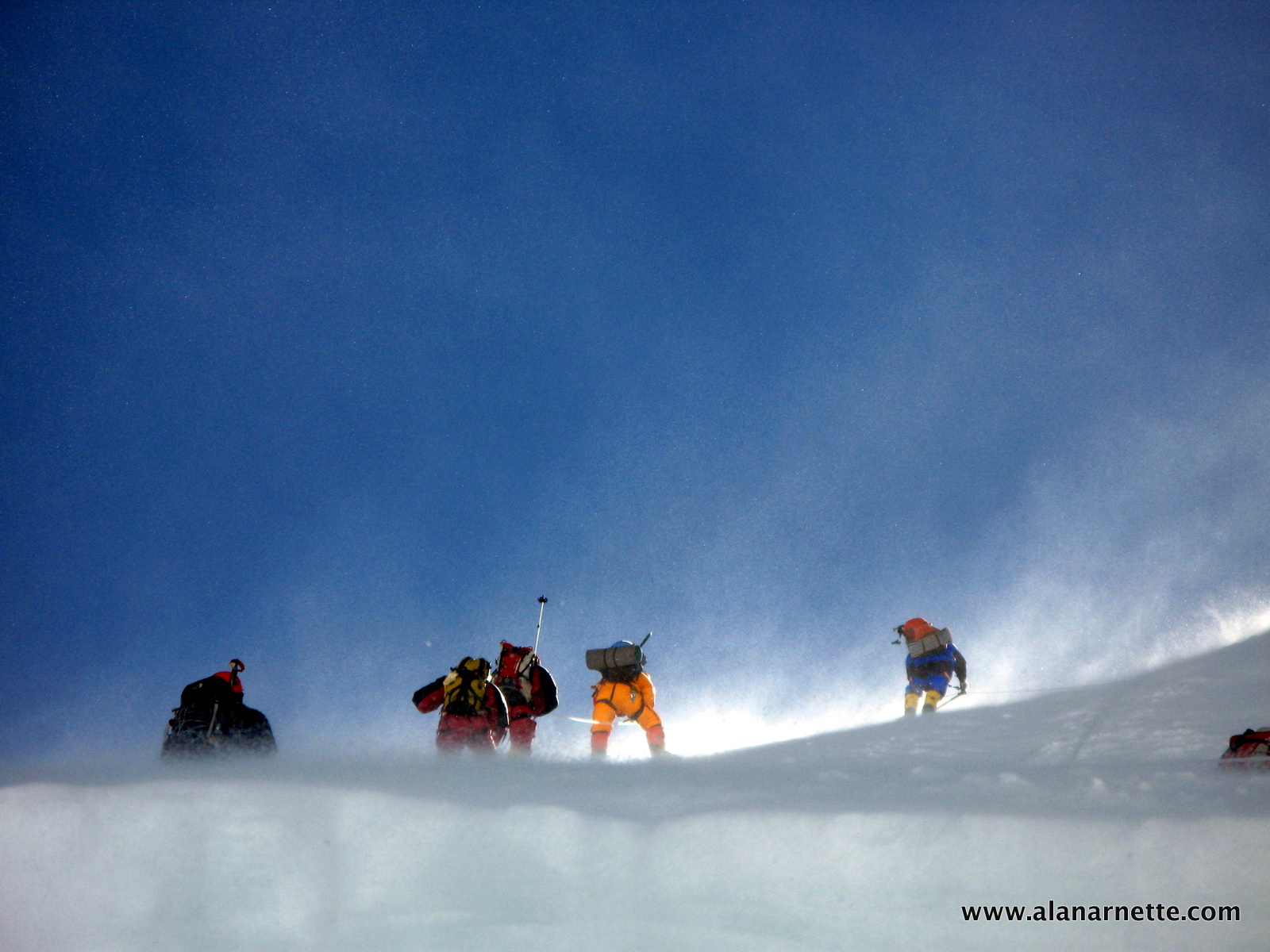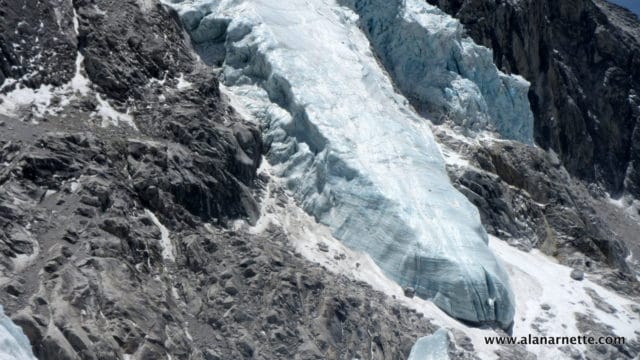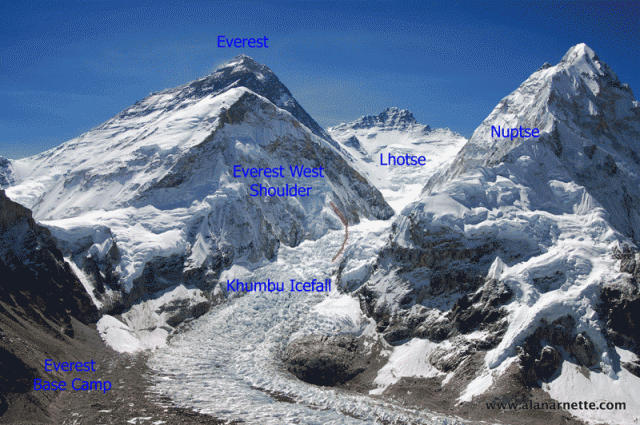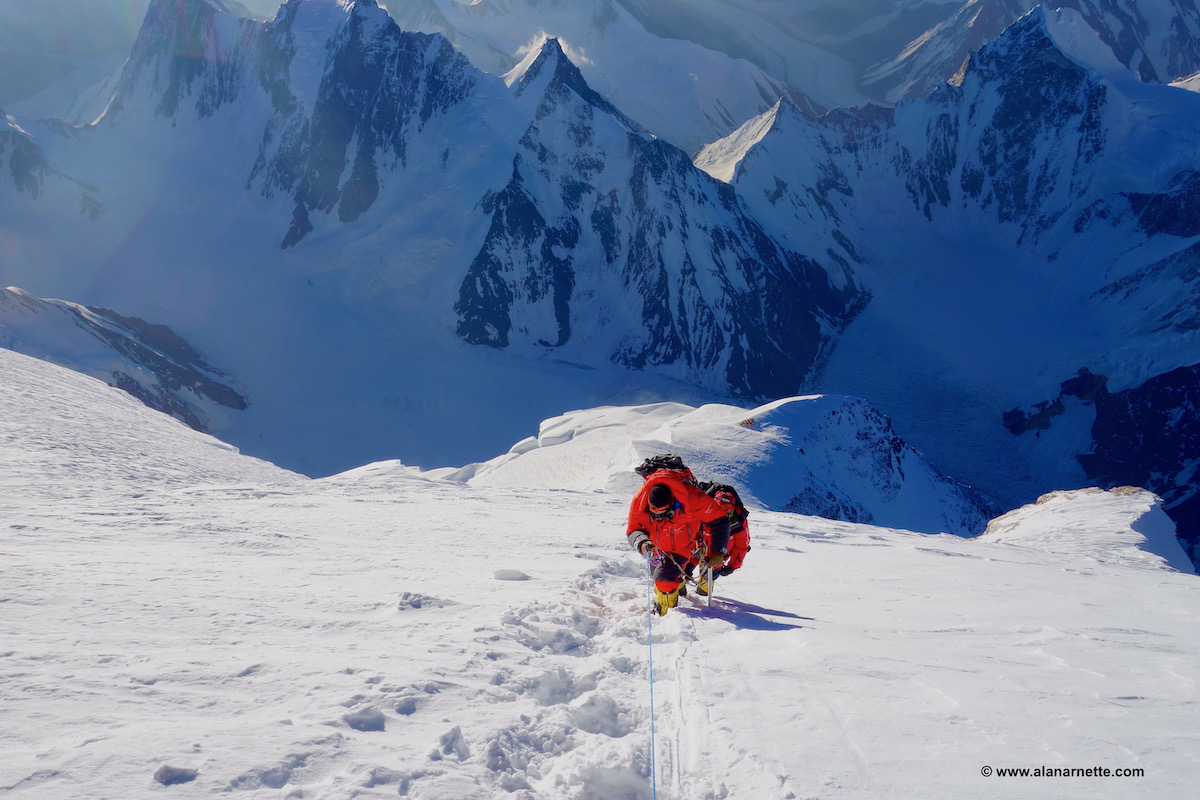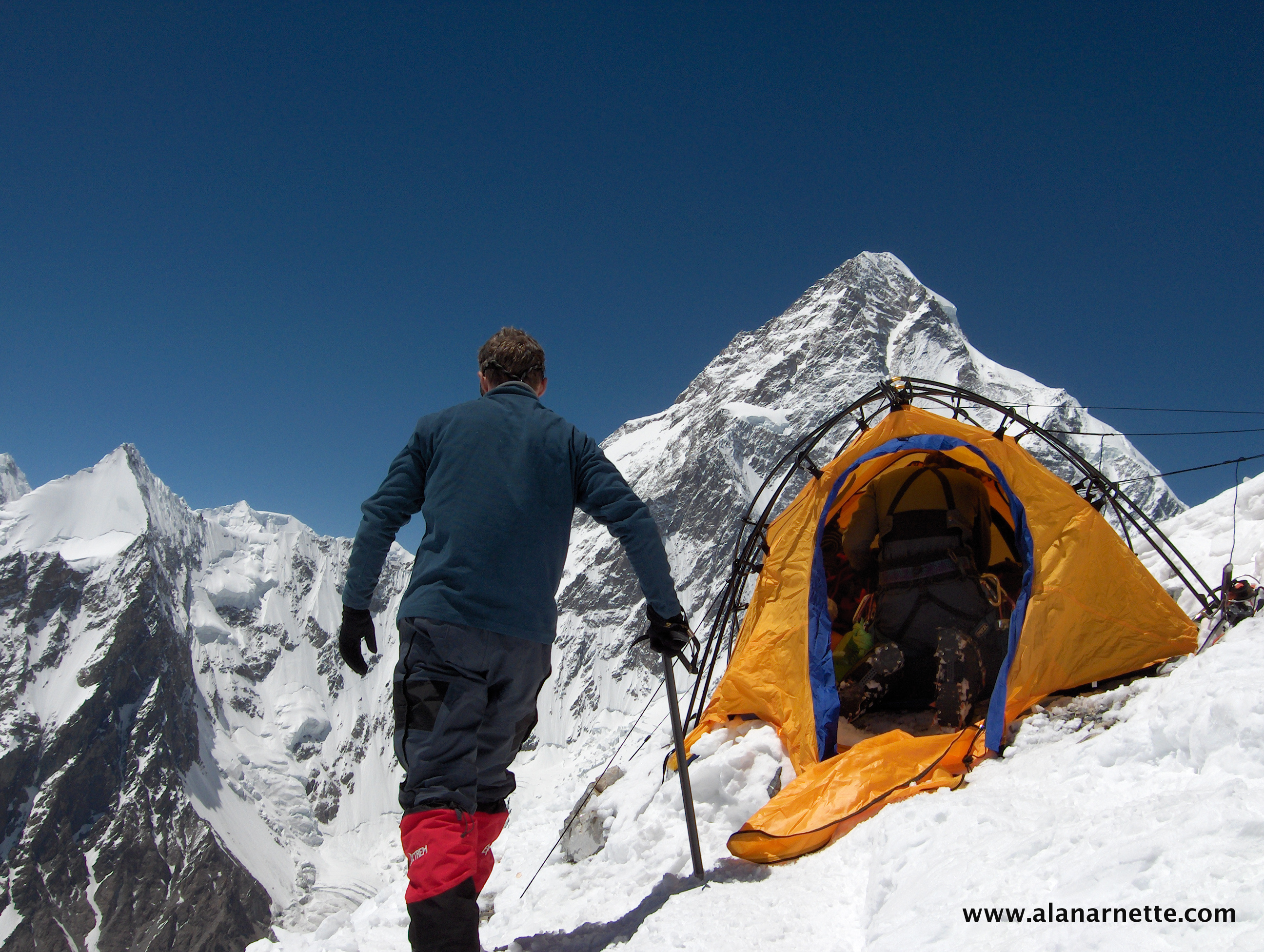It’s begun. Teams are now at Camps 1 and 2 on their first rotation. There are a very low number of ladders in the Icefall this year, only four. Work continues on Nuptse as an alternative to the Icefall. Everest permits are nearing 300. A deep dive into the Khumbu Icefall.
Big Picture
Climbing on Everest is in full swing with pujas completed, ropes to C2, members on their rotations, and hard-working Sherpas stocking all the camps. The Full Circle Everest team is at EBC:
The team has been at Everest Base Camp for a few days now, resting and acclimating. Our first acclimation climb was today to Pu Morí camp I which is at 19,000 feet (5,781m). We are off to go somewhere in the icefall tomorrow. Our team is fine, the weather, cold and snowing
Just off the phone with Expedition Leader Andy Polloczek who said everyone is doing great and excited to head up the Icefall for the Dry Run in the morning. The first trip into the Khumbu Icefall is called a Dry Run because we are not going all the way to Camp 1 but instead, getting into the Icefall for an opportunity to get a feel for the ups and downs of the route.
Our expedition leader Stu peacock phoned to say the Adventure Peaks team is making good progress and have spent nights now at Camp 1 and are currently up at Camp 2 on their first main rotation. They are hoping to reach the bottom of the Lhotse Face today. The Sherpa team have done an incredible job getting Camp 2 set up so quickly.
Hello from Camp 1! We left base camp at 2 a.m. and had good climbing conditions through the Khumbu Icefall with few people on the route. The team is strong, healthy overall. We’re looking forward to an acclimatization day here tomorrow before moving up to Camp 2.
The 8000ers
Teams are still on hold waiting for better weather on Kangchunga and Annapurna, including 83-year-old Carlos Soria. However, climbing has begun on Makalu. Alpenglow gives us this update:
The Makalu athlete teams have made it into Advanced Case Camp at 19,000′ (5,791m), their new home for the next 6 weeks or so. As they settle in, they’re starting to plan and get organized for the technical climbing above, discussing rope fixing strategy and checking the weather. Karl Egloff and Nicolas Miranda have started to push above ABC, making their way to touch C2 (6,200m) and coming back down to ABC as an acclimatization trek.
Kangchenjunga, the world’s 3rd highest peak, has the third most permits issued after Everest and Lhotse with 67 climbers on 6 teams. The Canadian John Gill’s ‘CanKan‘ team, supported by Namgya Sherpa’s Grand Himalaya Treks & Expedition reports in
Climbers have made it to mid camp on Yalung glacier, 4,850m. Hazardous day crossing loose rubble and ice with snow falling all day. Tomorrow should reach BC (basecamp)…6 hours left until they reach basecamp now as I post this. First view of Kanchenjunga today, lookin’ huge!
That’s all of today’s news. Now let’s take a look at the Khumbu Icefall and why it’s so feared.
A River of Ice that is Melting
Everything starts with the Khumbu Glacier, a 10-mile/17km river of ice that begins high on the Lhotse Face around 25,000’/7,600m. The Khumbu Icefall is the section between Everest Base Camp 17,300’/5270m and just below where Camp 1 is usually located, 19,500’/5943m.
Once it leaves Lhotse, the glacier defines the Western Cwm for about 2 miles before dropping rapidly to create the Khumbu Icefall for 2.5 miles. Around Everest Base Camp (EBC), the glacier makes a sharp southernly bend and continues another 6 miles/9.6km to 16,000’/4,900m. The Icefall varies in width from over half a mile/800m to a third of a mile/500m.

As with all glaciers, the Khumbu moves, as much as 3’/1m a day in the center while barely moving at the edges due to friction against rock walls. The top of the glacier moves faster than the bottom due to friction against the earth. It is this dynamic of fast and slow-moving sections plus the precipitous drop that creates the deep crevasses, some over 150’/45m deep, and towering ice seracs over 30’/9m high.
Melting
According to the Kathmandu-based mountain research institute, ICIMOD, the Khumbu Glacier is melting but not as fast as many other glaciers due to its altitude. It is the highest glacier on earth. It is estimated to be retreating about 65’/20m per year and has shrunk about 3,100’/940m between the 1960s and 2001. 1
However, in a February 2022 scientific analyst, Mt. Everest’s highest glacier is a sentinel for accelerating ice loss shouts an alarming alarm:
Mountain glacier systems are decreasing in volume worldwide yet relatively little is known about their upper reaches (>5000 m). Here we show, based on the world’s highest ice core and highest automatic weather stations, the significant and increasing role that melting and sublimation have on the mass loss of even Mt. Everest’s highest glacier (South Col Glacier, 8020 m). Estimated contemporary thinning rates approaching ~2 m a−1 water equivalent (w.e.) indicate several decades of accumulation may be lost on an annual basis now that glacier ice has been exposed. These results identify extreme sensitivity to glacier surface type for high altitude Himalayan ice masses and forewarn of rapidly emerging impacts as Mt. Everest’s highest glacier appears destined for rapid retreat.
The glacier has thinned by 177’/54m over most of its length. Everest Base Camp is lower today due to the ice melting. In 1953 when Hillary and Tenzing summited, EBC was about 17,454’/5320m; today it is 17,322’/5280m.
Between 1962 and 2002 the Icefall thinned by an average of 56’/17m, about a rate of 1.3’/39cm per year.
Long-time Everest guide Russell Brice commented told me in an interview in 2017 that this melting may result in a safer Icefall for climbers. But he added the Western Cwm may one day become the major obstacle of the South Col route:
But on Everest looking at photos from above, it seems that the Icefall between BC and C1 is actually getting easier and arguably safer. It also seems that several of the hanging glaciers above the Icefall are now leaning back and seem to be less active than what we experienced in 2012, again this can be explained by the warm temperatures at this altitude.
However it seems to me that the crevasses between C1 and C2 are getting deeper and are now longer which results in climbers having to walk longer distances as they zig zag through these crevasses, and of course this has also resulted in some longer ladder crossings over very deep crevasses. I will not be surprised to see that we will need more ladders between C1 and C2 than before. Maybe even at the bottom of the Lhotse Face as well.
Judging by the reports from 2022, it appears the long-time Everest veteran, who has now sold his company, Himex, was spot on. The route through the Icefall is faster with only four ladders in 2022 and flatter while the trek between C1 and C2 has to navigate massive crevasses.
The First Icefall Climbs
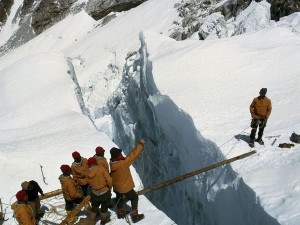
George Mallory while seeking a route to climb to the summit of Everest is said to have sighted the Icefall in the early 1920s and said it was “terribly steep and broken … all in all the approach to the mountain from Tibet is easier“5 thus shifted his efforts to Tibet.
It wasn’t until 1950 when Charlie Houston and Bill Tilman led a British reconnaissance team to scout a possible route from Nepal that the Khumbu Icefall was considered feasible.
In 1951, another British team led by Eric Shipton climbed thru the Icefall but stopped just short of the top due to a wide crevasse. To cross the crevasses, the early expeditions used long tree trunks brought up from the treeline after they ran out of ladders.
A 1952 Swiss team overcame that obstacle by climbing into the crevasse and crossing a dangerous snow bridge. They reached 8500 meters using today’s Southeast Ridge route but failed to summit. Of course, John Hunt’s 1953 British expedition made the first summit using that same route.
The Hazards
There are multiple hazards within the Icefall that have taken lives. I used the Himalayan Database to analyze the non-illness deaths between 17,500’/5400m and 19,500’/5940m and that was in the Icefall proper. There were 45 total deaths in the Icefall or 23% of the 194 total deaths on the Nepal side from 1950 to 2021.
The 45 deaths broke down as:
- Avalanche onto the Icefall: 22 deaths or 49%
- Section of Icefall collapsed: 15 deaths or 33%
- Falling into a crevasse: 6 deaths or 13%
- Fall: 1
- AMS: 1
While I cite specific deaths to help others, I extend my condolences to all family, friends, and teammates of these tragic events.
Crevasse: 6 or 13%
Falling into a crevasse is quite common on mountains from Mont Blanc to Rainer to Everest. I fell in one above Camp 1 in 2002! On Everest, the standard protocol is to be clipped into the fixed rope at all times while moving up or down the Icefall so that if you step on a soft snow bridge and fall into a crevasse or slip off a ladder, the rope will catch you. Sadly, many falls into crevasses were the result of not being clipped in.
In 2005, a westerner fell into a crevasse while crossing a soft snow bridge. Adventure Consultant team members who witnessed the fall all agreed: “It was clear that this climber was not clipped into the fixed ropes at the time of his fall; thus, a slip which should have been quickly arrested resulted in a fatal fall over a 10m drop.” 3 In 2012, a Sherpa fell from a ladder while not clipped into the fixed ropes and fell 150’/46m into a crevasse. 4
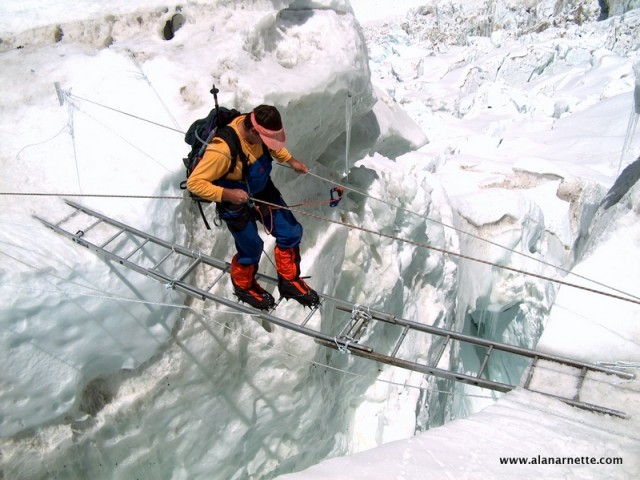
Icefall Collapse: 15 or 33%
The next hazard is being hit by an ice structure collapsing within the Icefall itself. There are many towering seracs (ice towers) that can fall over as the Icefall shifts or an entire section can simply collapse under a climber – remember it can move a meter each day and can shift suddenly with no warning. Amazingly, this event is not very common but can easily be the cause of death.
A tragic example is from 1972 when an Australian climber supporting Chris Bonnington’s British Everest SW Face Expedition was ferrying loads. He entered the Icefall but was not seen again. A search team found a big area of the Icefall that had collapsed and assumed he was in that area when it happened. In 2008, his body was found at the foot of the Icefall. 2
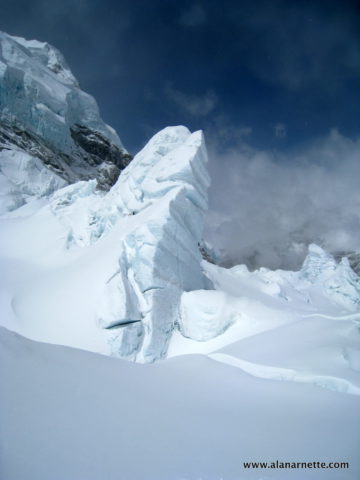
Avalanche: 22 or 49%
Ice falling off the West Shoulder of Everest has resulted in massive casualties and is widely considered the most pressing danger in modern times. This is the serac, Russell Brice mentioned earlier.
There have been two major events. In 1970, six Sherpas were killed while supporting a Japanese expedition and in 2014, one of the worse days in Everest history, 16 Sherpas died on 18 April when a hanging serac released as the Sherpas were waiting for a ladder to be replaced over a crevasse as they were ferrying loads to the higher camps.
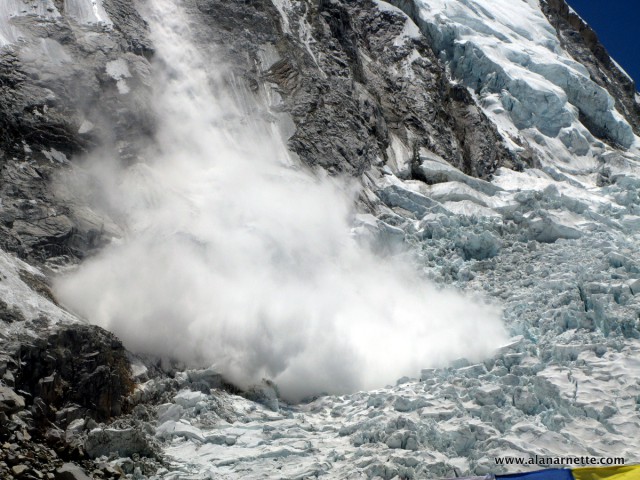
In the Autumn of 2019, a house-size piece of ice was barely hanging on about 3,000 feet above the Icefall. All of the teams attempting Everest that season ended their efforts fearing the serac would release just as they passed underneath similar to 2014. It’s now reported that it has released leaving a debris field across the Icefall.
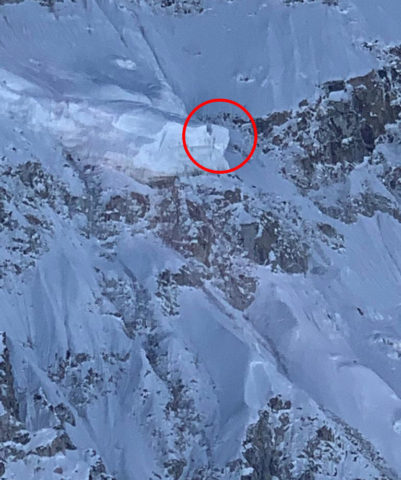
Who Does the Work?
The route thru the Icefall to Camp 2 is put in and maintained by a small team of Sherpas aptly called the Icefall Doctors.
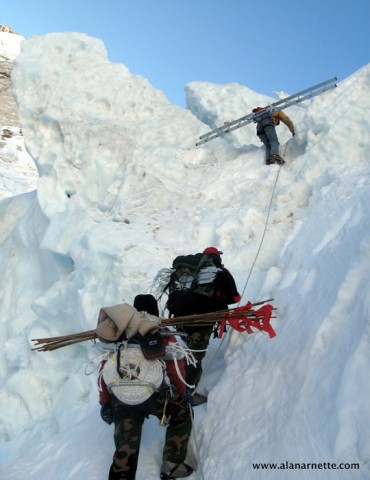
On the south side, the Icefall Doctors, a team of eight dedicated Sherpas install aka “fix” the route from Everest Base Camp to Camp 2 in the Western Cwm each year. They first scout the route for the safest and most direct path, then they carry on their backs hundreds of pounds of rope, ladders, ice screws, and pickets into the Icefall and the Western Cwm to create the route.
The ropes must be reset each season because the ultraviolet rays from the sun will rot the ropes causing them to fail under the weight of a climber’s fall. In addition, the route must be maintained daily throughout the season given the Icefall is a moving glacier and can move up to three feet a day. This movement will cause ladders to drop into crevasses, bend them, or move them into a dangerous area. The Doctors inspect the route at least once a day throughout the season to keep it open and safe.
From Camp 2 to the summit on the south side, the Expedition Operators Association (a group of guide company owners) awards the contract to set the line from C2 to the summit. In 2022 it was awarded to Seven Summits Treks.
Sherpas carry ropes and anchors on their backs and work together to fix the “fixed rope” aka safety lines to the mountainside. In 2017, a major change occurred when the Nepal government allowed the ropes and anchors to be helicoptered to Camp 2 thus saving an estimated 78 Sherpa loads thru the Icefall. This was a pure safety decision. Hopefully, they will allow it again in 2022.
The labor and material are funded thru climbing permits or collections from the teams.
It’s a difficult and dangerous job. In 2013, Mingmar Sherpa, one of the Icefall Doctors, died after falling into a crevasse between Camps 1 and 2 in the Western Cwm.
The Route
In the past decade, it had shifted more towards the West Shoulder because it was faster for the Icefall Doctors to create the route. But the danger was obvious with the serac looming overhead. Looking at old maps and pictures, long-time veterans Pete Athens and David Breashears suggested the route should return towards Nuptse as it was in the 1950s.
Starting in 2015, the Doctors did just that making it shorter and safer. The route was not fully tested as the earthquake ended that season early but in 2016 and 2017 they used the same path with good results, albeit with some sections being steep and difficult. Similarly good results in 2019 and 2021.
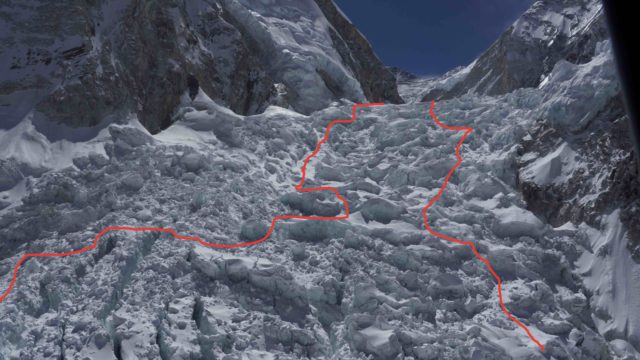

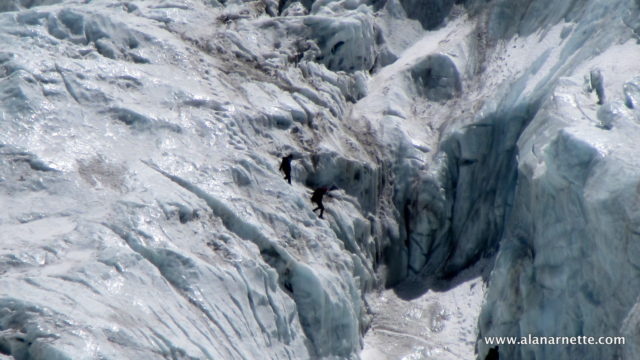
Bypass the IceFall?
Of note in 2022 is Marc Batard, who set a speed record in 1988 of 22:29 from EBC to the summit without supplemental oxygen. Now he wants to prove an alternative route to the Khumbu Icefall on the flanks of Lhotse. He said, “The new route follows a rocky spur below the flank of Mt Nuptse. The rocky spur, a vertical cliff, is a bit difficult. But after it is climbed, the route from there becomes easy to navigate. This will completely bypass the treacherous Khumbu Icefall. There is no danger of an avalanche in the Nuptse ridge.” He thinks it will take seven hours to reach Camp 1 in the Western Cwm.
It’s unlikely this will work, but good on him for trying. The slopes of Nuptse are steep, rocky, and as avalanche-prone as the West Shoulder of Everest. The technical difficulty is significant; thus, Sherpas making “speed” carries to stock the high camps would probably prefer the regular route to go faster. I doubt the Nepal Government will approve bolting Nuptse (but they did for a rap line on the old Hillary Step.) I also suspect that commercial guides will not allow their clients to climb such technical terrain. Most lack the skills to navigate this area safely. Of course, if it proves viable, it might be an alternative for expert climbers, but not the masses, in my opinion.
Safety in the Icefall
With all of this history, how do you protect yourself while climbing in the Khumbu Icefall?
For foreigners, it may take over 6 hours to climb to Camp 1 on the first rotation. Once they are acclimatized, that time can be cut in half but most people still take four to five hours. This means leaving base camp no later than 3:00 am. Sherpas will leave as early as 1:00 or 2:00 because they make a round trip. Impressively, they take the same time for a round trip as a foreigner does one way!
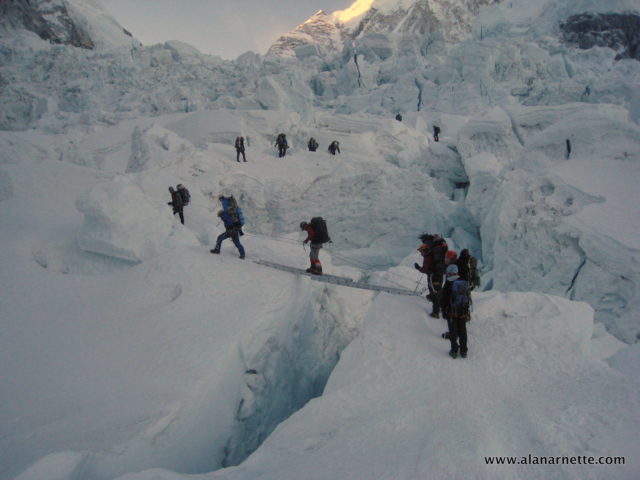
Skills Review
Most teams will take a few days to review basic skills before entering the Icefall. Sherpas will set up a short course with a couple of ladders and a fixed-line running over a large block of ice. While it may seem odd to others for anyone already at Everest Base Camp to practice clipping on and off a fixed rope, using a jumar, or front point on steep ice with crampons, this review sharpens everyone’s skills and is a good use of time.
Safety Habits
These are the most common precautions climbers use to protect themselves:
- Never be in the Icefall when the sun is touching the ice thus heating it up and causing movement
- Always be clipped into the fixed rope, including on ladders
- Never stop for more than a few minutes at any location in the Icefall
- Move as fast as you safely can
- Let faster climbers go by
But even these steps will not prevent something unexpected from occurring. The 2014 serac realize occurred well before the sun hit the Icefall. It was around 6:45 am and the sun usually touches the ice around 10:00 am. Also, ice screws that attach the fixed ropes to the ice will melt out removing the safety net provided by the ropes. So the best strategy is to move fast, be confident, and have extensive experience climbing in crampons on steep snow and ice – the more experience, the safer you will be.
Alan crossing a ladder from my 2008 climb:
And a video I took in 2014 after the earthquake flying over the Khumbu Icefall:
references
- https://glacierchange.wordpress.com/2009/12/09/khumbu-glacier-decay/
- https://books.google.com/books?id=Td0rVmVnkR8C&pg=PT49&lpg=PT49&dq=terribly+steep+and+broken+george+mallory&source=bl&ots=SYBw3DVWEU&sig=tGcuWRnMqpxDyxCAGom55ntaKJk&hl=en&sa=X&ei=aCrkVLvfOonXggSG1ICYAQ&ved=0CB4Q6AEwAA#v=onepage&q=terribly%20steep%20and%20broken%20george%20mallory&f=false
Nepal 2022 Permit Update as of April 20, 2022
The permits for Everest have picked up as expected, but I’m not anticipating a significant further increase. I’m anticipating between 250 and 300 total foreign permits issued for Everest. 2021 was a record year with 408 permits issued to foreigners. There have been 833 total permits issued for 23 peaks thus far from 73 countries.
Looking at Everest only, the US has the largest representation with 63 members, followed by the UK-33, Nepal (non-Sherpas)-20, India-22, Canada-17, Russia-16, France-12, China-10, and Austria with 10. There are 37 countries represented by a single climber.
These permits have generated $3.5M in royalties for the government. Almost all of this revenue stays in Kathmandu, with some in various personal pockets and none to the Sherpas, porters, or other high-altitude workers. The Nepal Ministry of Tourism posted these foreign permit tally as of April 19, 2022:
- Everest: 292 on 36 teams
- Ama Dablam: 97 on 9 teams
- Annapurna I: 26 on 4 teams
- Annapurna 4: 9 on 1 team
- Baruntse: 20 on 3 teams
- Bhemdang: 8 on 1 team
- Dhaulagiri: 27 on 3 teams
- Gangapurna: 2 on 1 team
- Himlung: 35 on 4 teams
- Khangchung: 67 on 6 teams
- Kangchung/UIAA: 2 on 1 teams
- Lhotse: 103 on 11 teams
- Makalu: 39 on 4 teams
- Manaslu: 9 on 1 team
- Mukot: 4 on 1 team
- Norbu Khang: 5 on 1 team
- Nuptse: 57 on 7 teams
- Phu Khang: 5 on 1 team
- Pokhar Kang: 9 on 1 team
- Saribung: 3 on 1 team
- Saula: 2 on 1 team
- Thapa (Dhampus): 10 on 3 teams
- Urknmang: 2 on 1 team
The Podcast on alanarnette.com
You can listen to #everest2022 podcasts on Spotify, Apple Podcast, Google Podcasts, Pocket Casts, RadioPublic, Anchor, and more. Just search for “alan arnette” on your favorite podcast platform.
Climb On!
Alan
Memories are Everything
Summit Coach
If you dream of climbing mountains but are not sure how to start or reach your next level from a Colorado 14er to Rainier, Everest, or even K2, we can help. Summit Coach is a consulting service that helps aspiring climbers throughout the world achieve their goals through a personalized set of consulting services based on Alan Arnette’s 25 years of high altitude mountain experience, including summits of Everest, K2, and Manaslu, and 30 years as a business executive.

